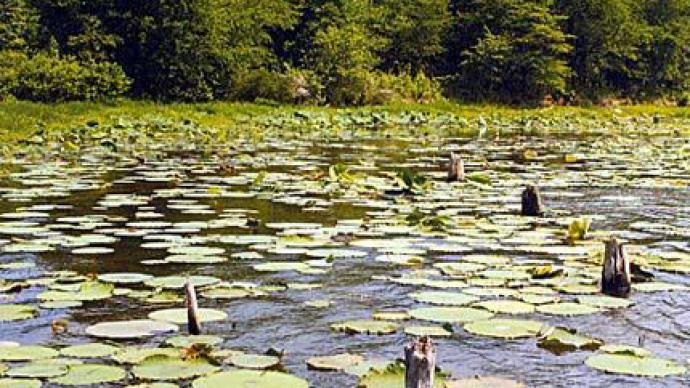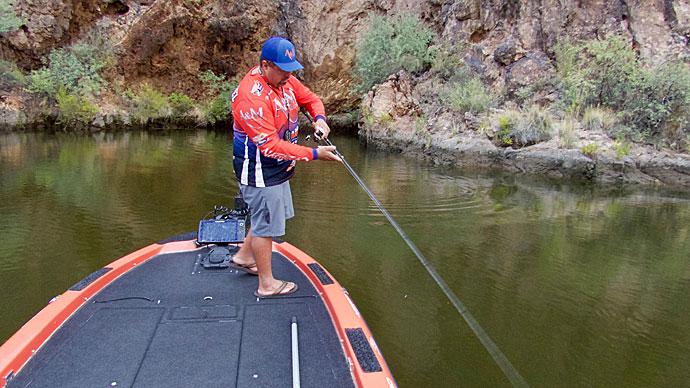
Using hollow-body frogs is one of my favorite ways to catch lots of bass during the dog days of summer. Though it may seem like a pretty one-dimensional lure, there are many ways to use frogs. I will highlight what rods, reels, lines, lures, and techniques are needed to use a frog successfully.
Techniques
The most common way to fish a frog is by slowly twitching it over and through thick, heavy vegetation. This can be lily pads, hydrilla, duckweed, or any other vegetation type. The bass are not just randomly scattered throughout the weeds, however. They like to be around any change, not just out in the middle of the weeds. The kind of changes you are looking for can be almost anything, such as where two types of weeds intersect, a tree or other type of cover that is within the weeds, the weeds making a point or indent, the edge of the weeds, a hole in the weeds, or anything else that is different from the surrounding area. Also, the fish move around in the weeds during the day. For example, in the morning, they might be out on the edge actively feeding but might move deeper into the weeds (more shade) as the sun rises. One time when I was fishing Clearfork Reservoir in Ohio, I got on the lake around 7:00 AM. Within the first fifteen minutes, I had caught a two-pounder out on the edge of the weeds. Then, as the sun rose, they moved farther back into the weeds (even though it was shallower than the edge) to where two types of weeds mixed. I caught the rest of my fish right on the line where the weed types changed.
Now that you know where the fish are, we will discuss catching them. Just cast your frog around the changes and work it slowly back to the boat. In heavy weeds, I use a twitch-twitch-pause-twitch cadence, to begin with, then change up until I start getting hits. Most of the time, they want a slow-moving frog, but other times they may want it chugged quickly and steadily. Just experiment until the bass tell you what they want.
If you are fishing more open water, walking your frog is a great way to catch them. I use this tactic around any shallow cover, where many people use a spinnerbait or shallow crankbait. You must have the right tackle for this presentation to work correctly, but we will discuss that later. I like casting or skipping the frog back into places nobody else can get their lure into. Instead of fishing around the edges of that tree hanging into the water, fire your frog right back into the heart of it. If you do it right, your frog will return 99% of the time. Once I get my lure back there, I walk it back out. My most common way to fish it is with a walk-walk-walk-pause cadence. However, once again, you must change your retrieve until you start getting strikes. Using the right frog, you can walk it almost in place, which annoys the bass into striking. To walk your frog, leave a little bit of slack in your line and twitch the slack, it may take a little bit of practice, but you will be walking your frog in no time.
Lures
There are hundreds of different frogs on the market. How do you know which one to buy? First, think about which technique you want it for. My favorite frogs for fishing in the thick vegetation are the Spro Poppin Frog and the Spro Bronzeye Frog. Many other frogs work for this type of fishing. Any frog that will come through the vegetation well will work. I like the Poppin Frog because it makes more commotion on top of those thick mats, making it easier for the bass to find. In sparser weeds, I like the Bronzeye because it looks and sounds more natural.
The best frogs for walking are those with narrow bodies and flat sides. My favorites are the Spro Poppin Frog and the Deps Slither K. These two frogs are very easy to walk because of their narrow bodies and flat sides. It takes a little practice, but after a while, you can walk these two frogs while only moving them forward an inch. The Slither K is designed to be walked and has a feather tail, so it has more action. If you use the lures I suggested, you will have a much easier and more enjoyable time learning to frog fish.
Tackle
Using the right tackle is the most critical part of frog fishing. If you have the wrong tackle, you will miss many more strikes, and the ones you do hook have a good chance of getting off.
Rods and Reels: If you don't use the right rod and reel, you will find it almost impossible to land the fish when fishing heavy cover. An excellent frog rod is the Powell 735 Frog Rod. It is a seven-foot-three-inch Medium Heavy Extra Fast action rod. It has plenty of backbone to get the fish in the boat but isn't so big that it's tiring to fish with all day. It's a stiff rod to work the frog and hook and land the fish. Many different reels will work for frog fishing. The most important thing is the reel must have a 7.1:1 gear ratio or more. You need the fast reel to hook the fish and get it out of the cover before it gets wrapped around and stuck. Get a high-quality reel that will last you a long time, and you'll be set.
Line: YOU MUST USE BRAIDED LINE. That is the essential part of your tackle. Braid has no stretch and is very strong. I use fifty or sixty-five-pound Sunline FX2 to get those fish out of the cover—braid cuts through the vegetation instead of getting hung up and wrapped around in there. Braid is the one thing you must have to fish frogs successfully.
BassResource may receive a portion of revenues if you make a purchase using a link above.




